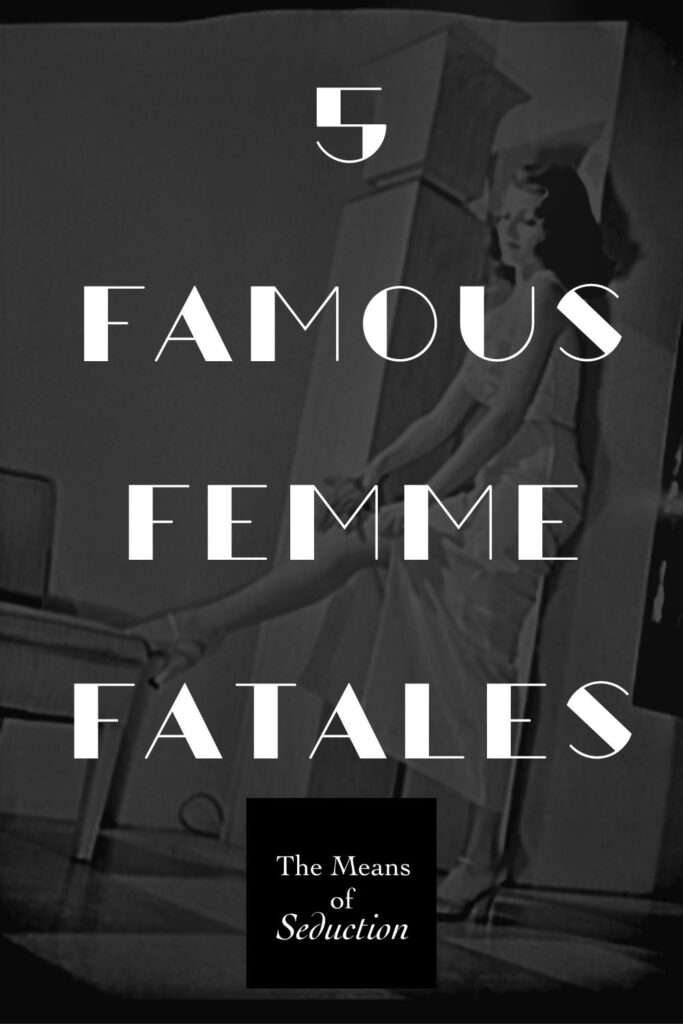Keep reading to learn more about these silver screen sirens and how you can emulate the seductive prowess of each one of our top five famous femme fatales…

1. Brigid O’Shaughnessy (Mary Astor) in The Maltese Falcon (1941)
Character: The femme fatale character of Brigid O’Shaughnessy used her beauty and vulnerability to manipulate detective Sam Spade into helping her, creating an air of mystery and dependence.
You’re a good detective, but a bad liar, Mr. Spade.
– Brigid O’Shaughnessy (Mary Astor), The Maltese Falcon (1941)
Application: Anyone can learn from Brigid O’Shaughnessy’s finesse for creating both a hint of mystery and a sense of dependence through her intentional interactions. To achieve this yourself, try sharing moments of vulnerability while maintaining intrigue. This means keeping the drama and details of your direness light but insisting (through compliments or indirect observations) that someone’s skills and abilities or resources could be of significant use to you. This will leave an impression that makes most people want to know more and help more, especially if they find the cause is exciting and worthy enough to pursue. Making someone feel valuable, for whatever it is that they can contribute to you, will help you get more from your interactions with them.
2. Vivian Rutledge (Lauren Bacall) in The Big Sleep (1946)
Character: The femme fatale character of Vivian Rutledge exuded seduction through her confident and smoldering demeanor, often using suggestive dialogue to entice private detective Philip Marlowe.
You’re not very tall, are you? Well, I will be seeing you.
– Vivian Rutledge (Lauren Bacall), The Big Sleep (1946)
Application: All of us can benefit from practicing seduction like Vivian Rutledge. Exuding confidence and a shameless, charismatic demeanor rarely fail to seduce. Engaged yet slightly detached body language conveys coyness and playfulness, while direct eye contact and suggestive yet tasteful banter demonstrates straightforward desire. This intoxicating blend of distance and restraint coupled with lustful wittiness and lighthearted spirit creates a magnetic and dynamic presence that is sure to leave an impact.
3. Phyllis Dietrichson (Barbara Stanwyck) in Double Indemnity (1944)
Character: The femme fatale character of Phyllis Dietrichson employed her charms and sensuality to manipulate insurance salesman, Walter Neff, into conspiring with her…and ultimately luring him into a murderous plot.
We’re both rotten.
“Only you’re a little more rotten.”
– Walter Neff (Fred MacMurray) to Phyllis Dietrichson (Barbara Stanwyck), Double Indemnity (1944)
Application: Each of us stands to better ourselves if we learn from Phyllis Dietrichson’s ability to use her charms to achieve her goals. In both social or professional settings, we are capable of leveraging our seductive qualities to influence others and get what we truly want. Using our charms (e.g., humor, sensuality, competitiveness, etc.), we can navigate the most difficult situations that stand to offer us the highest rewards and most desirable outcomes.
4. Elsa Bannister (Rita Hayworth) in The Lady from Shanghai (1947)
Character: The femme fatale character of Elsa Bannister moved with a seductive allure that was evident in her glamorous appearance and the way she enticed sailor, Michael O’Hara, into an atmosphere of danger and attraction.
When I start out to make a fool of myself, there’s very little can stop me. If I’d known where it would end, I’d never let anything start, if I’d been in my right mind, that is.
– Elsa Bannister (Rita Hayworth), The Lady from Shanghai (1947)
Application: A critical element of Elsa Bannister’s seductive allure is arguably the simplest and easiest to replicate: her physical self-presentation and exterior maintenance. By paying attention to our appearances (e.g., proper grooming and a unique sense of personal style), we can present ourselves with more confidence and grace, which will obviously make us more attractive and appealing to others. Maintaining your appearance certainly helps when it comes time to ask for favors and make requests of others. It’s much harder to say “no” to the pleas of a femme fatale that keeps herself polished.
5. Cora Papadakis (Lana Turner) in The Postman Always Rings Twice (1946)
Character: The femme fatale character of Cora Papadakis seduced Frank Chambers by her passionate and forbidden romance with him, leading to a dangerous love affair with deadly consequences.
With my brains and your looks, we could go places.
– Cora Papadakis (Lana Turner), The Postman Always Rings Twice (1946)
Application: All of us can admire and apply the romantic communication style of Cora Papadakis. Infusing romantic relationships with genuine passion and excitement inspires adventure that can lead to spontaneity and impulsivity – the perfect time for a femme fatale to strike with her biggest and boldest requests.
